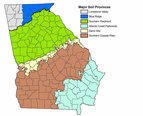
Soil in Georgia

Georgia has suffered terribly from the washing away of its topsoil. Millions of acres of productive land were degraded in the 18th and 19th centuries. In the mid-1930s, a federal law established the Soil Conservation Service to carry out programs to reduce erosion. In 1937 the Georgia General Assembly authorized the establishment of soil conservation districts (later called soil and water conservation districts).
Working with the Soil Conservation Service, the conservation districts coordinated the building of terraces and farm ponds, the improvement of pastures, the management of forests and wildlife, and the promotion of soil conservation education and incentive programs throughout the state. These activities continue today through the state’s 40 Soil and Water Conservation Districts, which are served by the Georgia Soil and Water Conservation Commission.
Most erosion occurs when rain falls on bare ground exposed by the tillage of cultivated crops. Increased use of such conservation practices as contour plowing, terracing, crop rotations, and later, "minimum tillage" or even "no tillage" has reduced erosion on cropland.
In the last 75 years, Georgia has seen dramatic changes in its landscape. Farm ponds for conserving water and providing recreation dot the landscape. Forest acreage has increased since early in the twentieth century, and timber stands are thicker. Even the more than half-million acres of roadways and roadsides, which used to be subject to serious erosion, are now stabilized with pavement, grass, shrubs, and trees. Construction sites that previously included no precautions against erosion now have structures to protect the soil or catch soil that washes off before it reaches the streams.
Since the mid-twentieth century in Georgia, the landscape, agricultural practices, and attitudes of its people have changed. The restoration of the bare, eroded hillsides, the silted streams, and the rutted and gullied roadsides is hardly noticed, but the improvements are remarkable nonetheless.
Information summarized from the New Georgia Encyclopedia
Testing Your Soil
Developing and maintaining productive soils begins with soil testing. Soils tests provide information on the soil’s actual nutrient status. Test results are used to determine the amount and kind of nutrients that should be added for the best growth of lawn, garden, and other types of plants.
The University of Georgia offers soil testing kits and information on soil testing.